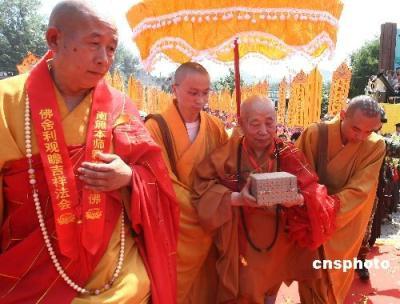|

|
|
Monks and Buddhists welcome two relics said to be from body of Sakyamuni, founder of Buddhism at Beijing Yunju Temple on Tuesday, June 23, 2009. The relics were returned to the temple from the Capital Museum.[cnsphoto]
|
Two relics said to be from body of Sakyamuni, founder of Buddhism, were returned Tuesday to the Beijing Yunju Temple, where they were first found, a temple official said.
The relics were welcomed by 108 monks and more than 400 Buddhists, as they returned from a underground storage room at the Capital Museum.
"I hope the traditional culture can be passed on through viewing the Buddha relics. I hope people's hearts can be purified," said Master Chuan Yin, who hosted the ceremony.
The relics will be exhibited until July 2 in the biggest hall of the temple, built in the Sui Dynasty (581-618).
The relics could be seen in detail via digital pictures on two large screens, said Yun Guirong, director of the administrative office of the temple.
The corn-shaped red Buddha body relics, discovered in the Leiyin Cave of the temple on Nov. 27, 1981, are respected as one of the "three precious" sets of relics in China. The others are Buddha teeth relics in Beijing's Lingguang Monastery and Buddha figure relics in the Famen Temple in Xi'an.
Buddha relics refer to the remains of Sakyamuni Buddha, founder of Buddhism, who -- according to legend -- left bones and 84,000 pearl-shaped relics.
Buddha relics are classified into three types: white bone relics, black hair relics and red body relics.